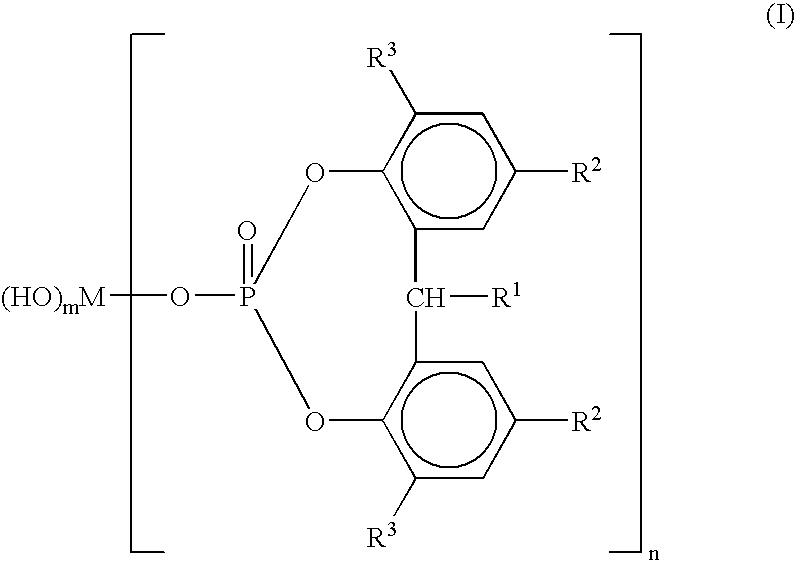Multi-layered film
a technology of multi-layered film and film layer, applied in the field of multi-layered film, can solve the problems of deterioration in longitudinal tearing strength, air-cooled inflation may not simply give a transparent film from a propylene-based resin, special resin, etc., and achieve excellent transparency, low temperature and interlayer strength, impact strength
- Summary
- Abstract
- Description
- Claims
- Application Information
AI Technical Summary
Benefits of technology
Problems solved by technology
Method used
Image
Examples
production example 1
[0189] (1) Catalyst Preparation
[0190] (i) Synthesis of racemic body of dimethylsilylenebis [2-methyl-4-(4-chlorophenyl)-4H-azulenyl] zirconium dichloride
[0191] It was prepared by the method disclosed by Example 12 of JP-A 10-226712.
[0192] (ii) Chemical Treatment of Ion-Exchangeable Silicate of Layered Structure
[0193] First, 200 g of chemically treated montmorillonite as the ion-exchangeable silicate of layered structure, prepared by the method disclosed by Example of JP-A 11-80229, was put in a 3 L glass reactor equipped with a stirring blade, to which 750 mL of normal heptane and then a heptane solution of tri normal octyl aluminum (500 mmols) were added. The mixture was stirred at room temperature for 1 hour, washed with normal heptane to a residual liquid rate below 1%, to prepare 2000 mL of the slurry.
[0194] (iii) Catalyst Preparation / Preliminary Polymerization
[0195] Next, a mixture of 870 mL of toluene slurry containing 3 mmols of (r) -dimethylsilylenebis [2-methyl-4-(4-c...
production example 2
[0202] The polymer (PP-2) was prepared in the same manner as in PRODUCTION EXAMPLE 1, except that ethylene and hydrogen were charged at 0.77 kg / hour and 0.10 g / hour, respectively, and the tank inside was kept at 70° C. in the step (iv). It contained ethylene at 2.0% by mass, and had an MFR of 7 g / 10 minutes, Tm of 135° C. and Mw / Mn ratio of 2.8.
production example 3
[0203] (1) Catalyst Preparation and Preliminary Polymerization
[0204] A flask, sufficiently purged with nitrogen, was charged with 200 mL of n-heptane treated beforehand to remove moisture and oxygen, and then with 0.4 mols of MgCl2 and 0.8 mols of Ti(O—n—C4H9)4. The reaction was allowed to proceed for 2 hours while temperature was kept at 95° C. On completion of the reaction, the system was cooled to 40° C., to which 48 mL of methyl hydrogen polysiloxane (20 centistokes) was added, and the reaction was allowed to proceed for 3 hours. The resulting solid component was washed with n-heptane.
[0205] Then, a flask sufficiently purged with nitrogen was charged with 50 mL of n-heptane, and then with 0.24 mols as Mg of the solid component prepared above. The resulting mixture was incorporated with 25 mL of n-heptane and 0.4 mols of SiCl4, and put in a flask over 60 minutes while temperature was kept at 30° C. The reaction was allowed to proceed at 90° C. for 3 hours.
[0206] Then, a mixtur...
PUM
 Login to View More
Login to View More Abstract
Description
Claims
Application Information
 Login to View More
Login to View More - R&D
- Intellectual Property
- Life Sciences
- Materials
- Tech Scout
- Unparalleled Data Quality
- Higher Quality Content
- 60% Fewer Hallucinations
Browse by: Latest US Patents, China's latest patents, Technical Efficacy Thesaurus, Application Domain, Technology Topic, Popular Technical Reports.
© 2025 PatSnap. All rights reserved.Legal|Privacy policy|Modern Slavery Act Transparency Statement|Sitemap|About US| Contact US: help@patsnap.com

